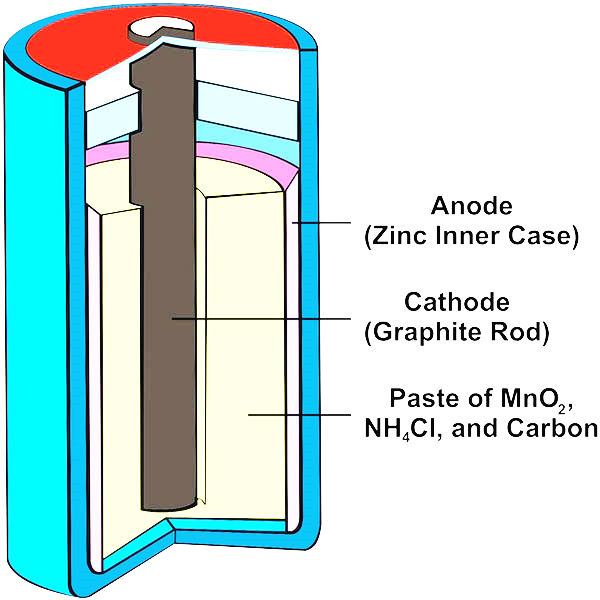
Answer
391.5k+ views
Hint: Electric cells are used to power devices such as clocks, calculators, and phones. It is a minor source of power. It's also known as a dry cell or a pencil cell. Chemical energy is converted into electrical energy by this device. A dry cell is a non-rechargeable main cell that cannot be used again. These cells are used in a variety of household items such as radios, transistors, tape recorders, calculators, and so on.
Complete answer:

The dry cell is one of many electrochemical cell types. The electrolyte is immobilised as a paste in a dry cell, with just enough moisture to allow current to flow. Since it has no free liquid, unlike a wet cell, a dry cell can run in any direction without spilling.
It consists of a zinc jar on one side of the cell with a narrow brass cap labelled positive (+) and a metal base on the other side of the cell labelled negative (-).
A carbon rod is inserted in the cell's middle, surrounded by a muslin bag containing a mixture of manganese dioxide (\[Mn{O_2}\]) and charcoal (C).
The electrolyte is a moist paste of ammonium chloride (\[N{H_4}Cl\]), plaster of Paris, starch, and other materials, and the zinc container's outer body (except the base) is insulated with thick cardboard or plastic.
Working:
As a cell is attached to a light bulb, the chemical reaction within the cell speeds up, and current begins to circulate through the bulb. As a result, the lamp illuminates.
These dry cells have a limited amount of power.
Note:
A typical dry cell has a zinc anode, which is typically in the shape of a cylindrical tub, and a carbon cathode, which is usually in the shape of a central rod. The electrolyte is ammonium chloride, which is applied to the zinc anode as a paste. A second paste made of ammonium chloride and manganese dioxide fills the vacuum between the electrolyte and the carbon cathode, with the latter serving as a depolariser. Ammonium chloride is substituted with zinc chloride in some projects, which are mostly sold as "heavy duty."
Complete answer:

The dry cell is one of many electrochemical cell types. The electrolyte is immobilised as a paste in a dry cell, with just enough moisture to allow current to flow. Since it has no free liquid, unlike a wet cell, a dry cell can run in any direction without spilling.
It consists of a zinc jar on one side of the cell with a narrow brass cap labelled positive (+) and a metal base on the other side of the cell labelled negative (-).
A carbon rod is inserted in the cell's middle, surrounded by a muslin bag containing a mixture of manganese dioxide (\[Mn{O_2}\]) and charcoal (C).
The electrolyte is a moist paste of ammonium chloride (\[N{H_4}Cl\]), plaster of Paris, starch, and other materials, and the zinc container's outer body (except the base) is insulated with thick cardboard or plastic.
Working:
As a cell is attached to a light bulb, the chemical reaction within the cell speeds up, and current begins to circulate through the bulb. As a result, the lamp illuminates.
These dry cells have a limited amount of power.
Note:
A typical dry cell has a zinc anode, which is typically in the shape of a cylindrical tub, and a carbon cathode, which is usually in the shape of a central rod. The electrolyte is ammonium chloride, which is applied to the zinc anode as a paste. A second paste made of ammonium chloride and manganese dioxide fills the vacuum between the electrolyte and the carbon cathode, with the latter serving as a depolariser. Ammonium chloride is substituted with zinc chloride in some projects, which are mostly sold as "heavy duty."
Recently Updated Pages
10 Examples of Evaporation in Daily Life with Explanations

10 Examples of Diffusion in Everyday Life

1 g of dry green algae absorb 47 times 10 3 moles of class 11 chemistry CBSE

What happens when dilute hydrochloric acid is added class 10 chemistry JEE_Main

What is the meaning of celestial class 10 social science CBSE

What causes groundwater depletion How can it be re class 10 chemistry CBSE

Trending doubts
Fill the blanks with the suitable prepositions 1 The class 9 english CBSE

Which are the Top 10 Largest Countries of the World?

How do you graph the function fx 4x class 9 maths CBSE

Who was the leader of the Bolshevik Party A Leon Trotsky class 9 social science CBSE

The Equation xxx + 2 is Satisfied when x is Equal to Class 10 Maths

Differentiate between homogeneous and heterogeneous class 12 chemistry CBSE

Difference between Prokaryotic cell and Eukaryotic class 11 biology CBSE

Which is the largest saltwater lake in India A Chilika class 8 social science CBSE

Ghatikas during the period of Satavahanas were aHospitals class 6 social science CBSE




